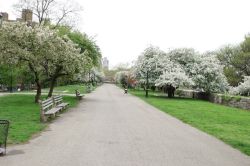Riverside Park
View all monuments in NYC Parks, as well as temporary public art installations on our NYC Public Art Map and Guide.
Louis Kossuth
| Artist: | John Horvay |
| Dedicated: | March 15, 1928 |
| Location: | Riverside Drive at 113th Street |
Artwork History
For many years on March 15th, Hungarian Independence Day has been celebrated on Riverside Drive at the monument to patriot Lajos Kossuth (1802-94). The bronze tableau portrays a vignette of the struggle for Hungarian independence in 1848. Atop a pedestal of Milford pink granite, a larger-than-life figure of Kossuth motions to two other male figures at the base: a revolutionary soldier and an aged peasant, representing Hungary’s new republic and old regime.
Kossuth was born to a family of noble heritage in Monok in northeastern Hungary. In the early 1830s, he emerged as a leader of the country’s radical reform movement. Trained as a lawyer, Kossuth edited several journals and newspapers that allowed him to broadcast his increasingly popular ideas. He issued fiery pleas for Hungary’s independence from Vienna’s Hapsburg Monarchy, for emancipation of the peasants, and for industrial development. Kossuth was elected to the Hungarian Diet (national assembly) in 1847, and a year later he led the revolution that created a new national government for Hungary.
The new government fell to invading Russian and Austrian armies in 1849, and Kossuth fled into exile. Rallying support for Hungarian independence, he dazzled European and American audiences with his eloquence. Sympathizers in the United States identified with the aims of overthrowing the foreign monarchy and establishing republican government for Hungary. Kossuth visited New York in December 1851 at the start of a seven-month tour of the United States. Upon arrival, he was given a tremendous welcome, described in the newly-founded New York Times as one of "the most magnificent and enthusiastic ever extended to any man in any part of the world." A reception hosted by Mayor Ambrose C. Kingsland, banquets, and a parade up Fifth Avenue were held in his honor. Kossuth lived in exile in England and (after 1865) in Italy. After his death in Turin in March 1894, his body was brought to Budapest and buried in state.
On March 15, 1928, a crowd of 25,000 gathered at Riverside Drive and 113th Street to dedicate the monument to Lajos Kossuth, designed by Hungarian sculptor Janos Horvai (1873-1944) and funded by American citizens of Magyar origin. The ceremony was not without controversy. The delegation of 520 Hungarian public officials encountered a protest denouncing the conservative Horthy government for "hypocrisy" in honoring Kossuth and his liberal ideals. In 1930, the monument had to be dismantled due to poor fabrication; later a second cast was installed. The monument was originally intended to feature three bronze panels depicting scenes in the life of Kossuth; instead, in 1930, Horvai presented the panels to the First Hungarian Reformed Church, located at 344 East 69th Street.
Riverside Drive stretches along Riverside Park from W. 72nd Street north to Dyckman Street. In consideration of New York’s northward expansion, the City acquired land between the Hudson River Railroad and the rocky bluffs along the river in 1866-67 for a park and scenic drive. The original 1875 plan, by Central Park co-designer Frederick Law Olmsted, called for a park with a picturesque drive winding along the natural contours of the land. Twenty-five years later, the result was an English-style rustic park and a formal tree-lined boulevard. A fashionable address at the turn of the century, Riverside Drive attracted a collection of substantial neo-classical apartment houses and mansions along its east side. The Drive’s majestic elevation also made it an impressive location for colossal monuments and institutions, including Grant’s Tomb (1897) and Riverside Church (1930). The Kossuth tableau is one of more than a dozen monuments which adorn Riverside Drive, including sculptures of Samuel Tilden (1926), Joan of Arc (1915), and Franz Sigel (1907).
Artwork Details
| Description: | Portrait & group on pedestal |
| Materials: | Bronze, Milford pink granite |
| Dimensions: | H: 22' W: 22' D: 22' |
| Fabricator: | Dodd's Granite Co. (?) |
| Donor: | Kossuth Monument Committee |
Inscription
KOSSUTH/* / ERECTED BY A / LIBERTY LOVING / RACE OF / AMERICANS / OF/MAGYAR ORIGIN / TO / LOUIS KOSSUTH / THE / GREAT CHAMPION / OF
LIBERTY / * / KOSSUTH MONUMENT COMMITTEE / CEZA D. BERKO, PRESIDENT/
MARCH 15, 1928
Please note, the NAME field includes a primary designation as well as alternate namingsoften in common or popular usage. The DEDICATED field refers to the most recent dedication, most often, butnot necessarily the original dedication date. If the monument did not have a formal dedication, the yearlisted reflects the date of installation.
For more information, please contact Art & Antiquities at (212) 360-8163.
Check out your park's Vital Signs
Clean & Safe
Green & Resilient
Empowered & Engaged Users
Share your feedback or learn more about how this park is part of a
Vital Park System

Know Before You Go
Related inquiries may be sent to boatbasin@parks.nyc.gov
Related inquiries may be sent to boatbasin@parks.nyc.gov



